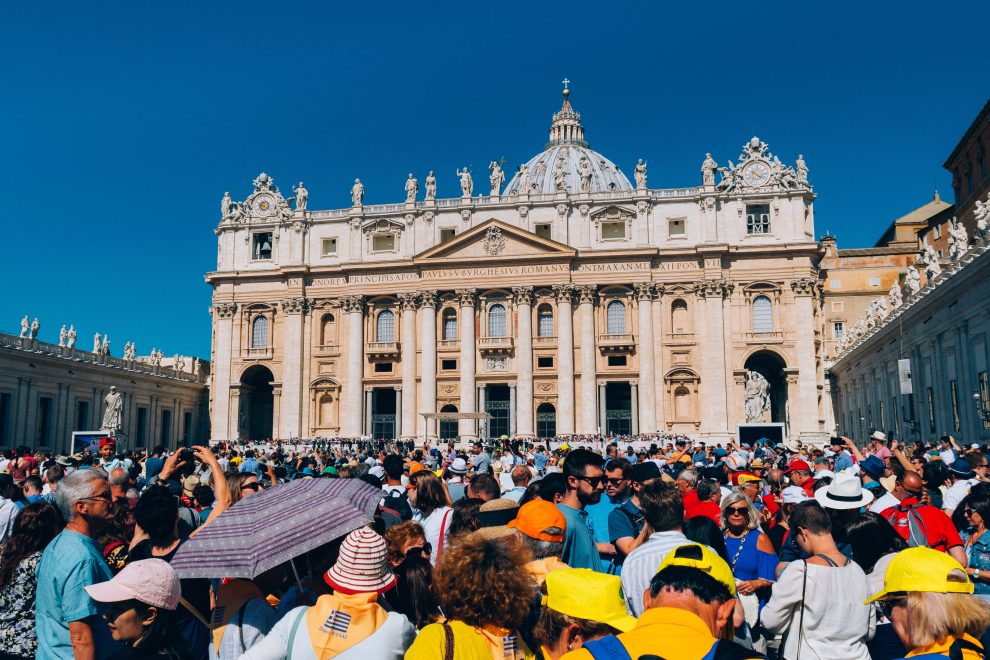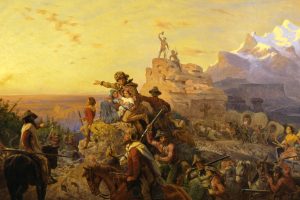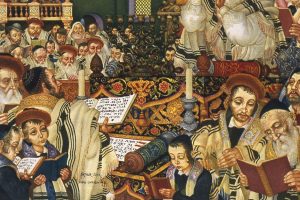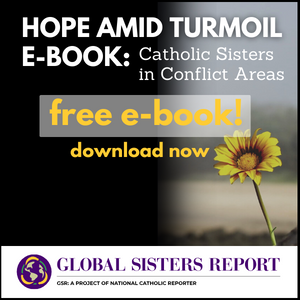The Second Vatican Council, which opened on October 11, 1962 and concluded on December 8, 1965, was the central event of Catholic life in the 20th century. Pope John XXIII called for the council to “open the windows” in the church to the world. John said he called the council to renew “ourselves and the flocks committed to us, so that there may radiate before all men the lovable features of Jesus Christ, who shines in our hearts that God’s splendor may be revealed.”
There were four years of preparation before the council and four sessions of the council itself. After John died in 1963, Pope Paul VI presided over the last three sessions. Voting members were all the world’s Catholic bishops from both the Western and Eastern rites, superiors-general of religious orders, and prelates with their own special spheres of jurisdiction. There were more than 2,600 delegates in all. Including the 480 so-called periti (theologians and other experts), more than 3,000 participated. The largest previous council, Vatican I, had 737 in attendance. The council produced 16 documents, all of which had to be approved by the pope before they became official.
In 1995, marking the 30th anniversary of the conclusion of the council, U.S. Catholic magazine collected the accounts from eight prominent Americans who played a role at Vatican II on their expectations of the council, their most vivid memories, and their view of the state of Vatican II renewal in subsequent years. None of them is alive today, and neither is the author of the article, long-time Washington-based religion writer and editor Jim Castelli.
The following is a slightly edited and updated version of the article, the original of which first appeared in the September 1995 issue of U.S. Catholic.
Father Walter M. Abbott, S.J. was best known as the editor of the English-language version of the 16 documents produced by Vatican II and commentaries on them. “We had it out three months to the day after the end of the council,” he said. “I never worked so hard in my life as I did getting that book out.” That assignment only developed in the last year of the council, but Abbott attended the third session at the invitation of Cardinal Leo Suenens of Brussels, one of the four council moderators. “He said he’d like me to come to experience what probably would be one of the greatest experiences of my life,” Abbott said, “and he was absolutely right.”
Expected accomplishments
I thought it was a God-given opportunity to help the idea of the common Bible. The time had come for Catholics and Protestants to produce new translations of the Bible together, so that Christians could use them together. And, one step further, that editions of the Bible could be prepared for non-Christians and that Christians together could join in distribution of those scriptures. It worked out. It was approved in the final session of the council, the sixth chapter of the Constitution on Divine Revelation.
Vivid memories of the council
For me the greatest day of the council was the day when the Constitution on Divine Revelation was promulgated by Pope Paul VI. The second greatest experience was the approval and promulgation of the Decree on Ecumenism, because I had been at work in the ecumenical movement from 1958. It was such a wonderful thing to have the pope and all the bishops declare that we Catholics should have respect, esteem, and affection for our separated brethren the Protestants.
My most embarrassing moment was the morning I stopped everything in the middle of a speech being given by a Spanish cardinal against the idea of religious freedom. I was sitting behind St. Peter’s altar with Father John Courtney Murray, one of the two drafters of that document. I had my feet on the bench in front of me, which was a little lower—a long oak bench, very heavy. I was rocking it gently without realizing it, and it went forward and smashed on the floor below.
It sounded like a cannon shot, and it brought the whole council to a complete stop. There must have been 2,400 bishops there that day, and every head in the basilica had spun in my direction. John Courtney Murray and I sat there as if nothing had happened.
After the morning session one of the cardinals asked me, “Walter, you caused that sound didn’t you? What did you do?” I asked, “How do you know I caused that sound?” He replied, “I was near enough to see that you got red to the roots of your hair.”
State of Vatican II renewal in subsequent years
A great deal of what Pope John XXIII wanted from the Second Vatican Council was achieved. What he wanted was to have a new presentation of the Catholic faith so that non-Catholics throughout the world could see the “radiant face of Christ shining through the church.” That was achieved in the Decree on Ecumenism.
The council also moved forward the idea of Catholic people reading and using the Bible. That had been advocated by the popes from Leo XIII on, but that message never really got to people effectively. When the Second Vatican Council produced that message, the people heard it, and it has made a tremendous difference ever since. Catholic people have turned more and more to the Bible, and its place has been restored.
Father Godfrey Diekmann, O.S.B. was a member of the preparatory commission that wrote the draft for Sacrosanctum Concilium, the Constitution on the Sacred Liturgy, which was substantially passed and prompted the far-reaching liturgy reform in the years after the Council. He was a peritus from the second to the fourth sessions and then became a member of the concilium for the implementation of liturgical documents.
Expected accomplishments
I was very strongly involved in the pastoral liturgical movement before the council. That was a deeply spiritual movement that resulted in recovering important theological insights from the time of the church fathers. I think the great spiritual renewal before the council was the liturgical movement.
That took place through the experience of the dialogue Mass, at which people realized that they were the church and that when Christ said, “When two or three are gathered in my name,” he was describing them.
It was the beginning of the realization that the local community is the church, not just a geographical division. It meant further realization of Christ’s presence among them, which is one of the important insights of Vatican II, that Christ is not merely present in the Eucharist or up in heaven somewhere. All those were inspired by the doctrine of the Mystical Body of Christ.
Vivid memories of the council
Vatican II was a series of miracles. The curia, who assist the pope in governing the church, was not at all satisfied with what John XXIII was doing. When they finally had to capitulate, they prepared 36 drafts to be discussed—a huge number—which made it seem as though they were sabotaging the council itself. But before the council was started, the 36 was whittled down to 16. The liturgy document was slated in the eighth place for treatment. Then on the very first day, the council fathers rebelled. They said we didn’t come here just to review or to rehash theology textbooks, because all those drafts had been prepared by the Roman theologians.
The only exception was the liturgy document, which had been prepared by about 55 pastoral liturgists from all over the world who had met several times—without any hope of a council—to share experiences and develop a common understanding. There was not a single Roman theologian among us. In that document we brought the new insights into theology stemming from the experience of liturgy and the doctrine of the Body of Christ.
The council fathers were confronted with the document on the liturgy, and before long they realized they had bitten off more than they could handle. It took them two years to bring it to conclusion. In the preparatory commission, Father Joseph Jungmann, S.J. said, “Are we sure we know what we’re doing? This document is very, very radical, actually. How many bishops will realize what it’s all about? How can we possibly expect a green light on this thing?” We had a showing of hands among the 55 of us of how many of the 2,400 bishops would have any real understanding and sympathy for the liturgical revival. None thought it would be more than 40.
Then Bishop Spülbeck from Meissen in East Germany said, “East Germany is communist and anything I say is off the record because if it ever comes out, I won’t be able to go back to my country. You’re wondering whether you should continue and express your hopes in this rather radical document. In East Germany the church is being persecuted. All we’re allowed now is the Sunday Mass. We want the liturgy to be, as the liturgy document says, “the source and center of the spiritual life.” It was an impassioned plea.
State of Vatican II renewal in subsequent years
The great tragedy of the present time is that much has been accomplished, but the spirit to a large extent has gone. The most important thing in the entire council was the recovery of the Body of Christ. I think it’s a tragedy that so many people think the council was famous because it stressed the People of God idea. The People of God idea was meant as a supplemental idea to the Body of Christ.
The Holy Spirit was there in a very manifest way, and if we mess it up it’s our own damn fault. The Holy Spirit is very close to the church today, and I hope we live up to that. {C}
Msgr. John J. Egan was a veteran social activist. “I wasn’t a peritus or anything like that,” he said. “I attended three of the four sessions because I believed that a church council wasn’t to be missed. So I used my vacation time and managed to get a room at the Villa Nova where the periti stayed.”
Vivid memories of the council
John Courtney Murray lived at the Villa Nova. He had a great love for the church as well as a great intellect. I’ll never forget his coming in one night and almost shouting, “Jack, we won!” I recall Msgr. George Higgins and Bishop Mark Hurley. Those two would gather around the ice machine and argue one issue after another. George loved a good fight.
Msgr. John S. Quinn, a peritus from Chicago, organized the bishops and got the council back on the agenda. He also brought that ice machine to the last three sessions. It became the focal point for the experts and the bishops. Americans like their drinks with ice.
Cardinal Albert Gregory Meyer of Chicago and Courtney Murray put on a full court press for religious liberty. It was wonderful to watch.
The Roman Curia had its own agenda for Vatican II, but by the end of the first week of the second session the entire agenda had changed. Gaudium et spes, the Constitution on the Church in the Modern World, was rewritten from top to bottom. In the first session, the bishops thought that they were going to do it all themselves. But gradually they consulted the periti more, and things began to change.
State of Vatican II renewal in subsequent years
John Courtney Murray said during the council that we would have to expect some 25 years of confusion but that we will see a glorious church emerging from it all. Well, the confusion has lasted a little longer, but we’re still a better church because of it.
I think we have to go back to the documents and read them again. I don’t think that what they call for has been fully implemented. I regret that the liturgists moved as quickly as they did. I think we deprived our people of much of their devotional life. It was much the same with the music; we still haven’t got the music quite right. But overall it was a great council.
Msgr. George G. Higgins was a peritus to the commission on the lay apostolate, which was merged into the commission on the church in the modern world. He also served on the press panel set up by the U.S. bishops to provide daily briefings to reporters.
Expected accomplishments
Like many people, I went to the council not knowing what to expect. There had been no experience in the United States, there was nobody living who had been in a council before, so that most of us went in rather blind. It was very providential that it lasted that long so that it could develop its own dynamics. I think if there had been only one session, we wouldn’t be talking about the council today. It took a process of growth and development.
Vivid memories of the council
I had a particular interest in two of the documents as an American, the one on religious freedom—I think most of the Americans did—and the one on Catholic-Jewish relations. Theologians, however, would say that the most important document was the one on the church. Biblical scholars probably look to the one on divine revelation as being extremely important.
State of Vatican II renewal in subsequent years
The big question still hanging in the air is the relationship between collegiality and papal primacy. It was discussed in the council but not completely resolved, and I personally doubt that it will ever be finally resolved. It’s one of those tensions built into our theology that will vary from one papacy to another and one period to another.
The next council will certainly be much more oriented toward the Third World by the very nature of the demography of the church and the hierarchy. Vatican II was much more European and North Atlantic, not only in its makeup, but certainly in the direction it took. I doubt that would be true the next time.
Bishop Mark J. Hurley, the retired bishop of Santa Rosa, California, was a peritus of the council and peritus to the commission on seminaries, universities, and schools. He was also a member of the American press panel. He attended every session of the council.
Expected accomplishments
Once you got there it was almost like a game, and you began to cheer for the teams. You spent morning, noon, and night hoping that things would succeed. There were a lot of contests in reference to various subjects. There was a real question whether the document on religious liberty would ever reach the floor.
As a matter of fact, Cardinal Augustin Bea, S.J., chief protagonist, if you will, sent for George Higgins and me in the early stages of the council and asked for two things. First, how would the American bishops respond to a document on religious liberty? We responded that we thought at least 95 percent would vote favorably. Second, how would they respond to a document on the Jews? We said 90 percent would vote favorably. And that’s the way it turned out. They were overwhelmingly in favor.
Vivid memories of the council
We lived at the Villa Nova, which was a pensione run by French nuns in Rome, and in that house we had somebody who was on every single commission. One of the most vivid memories by far was the time at the end of the third session when Cardinal Eugene Tissarant, as president, announced that there would be no vote on the religious liberty document. That just sent the council, in particular the American bishops, into high gear.
We went immediately down onto the floor and we got a petition. Cardinal Meyer, one of the 12 presidents of the council, was on the floor, and he led what you might call an outburst against it. It wasn’t scheduled, there was nothing in order, and the periti were scurrying around asking bishops to sign a petition to the pope objecting to what was done.
We typed it up right on the floor, and I said to Cardinal Meyer, “Cardinal, you haven’t signed it yourself yet.” And I held it for him as he signed it. Then he led a delegation of bishops to Pope Paul, and the pope then promised that it would be brought up right away in the fourth session. That was a very dramatic moment.
Another dramatic moment was when the patriarch came from the Greek Orthodox Church and he and the pope embraced in the sanctuary and disavowed the schism between the East and West, disavowing the excommunications that were hurled in both directions. Another high point: Archbishop Joseph T. McGucken of San Francisco left the council a week early, and I got to sign about four of the major documents for the archdiocese. So 500 years from now they’ll find my name in there.
State of Vatican II renewal in subsequent years
I think that one of the things that has encouraged me tremendously is that the pope has a chapter in his book on the council, and he supports the council. He says that we have to implement and build on the council. That is a very positive step because there are an awful lot of negative things said about the present pope trying to veto or override the council.
At the end of the council there was a banquet at the Villa Nova, and we had a resolution signed in which the different theologians and leaders said that the council is the beginning, that we must go ahead and implement the council. And the first two who signed were the German theologians Hans Küng and Joseph Ratzinger.
We became very, very strong advocates for the council, and most of us have remained that way.
Father Frederick R. McManus was a peritus to the commission on the liturgy, a member of the commission that planned for the liturgy document, and a member of the post-conciliar commission that implemented the liturgy document. He attended all sessions of the council and wrote a weekly column for the St. Louis Review. He said, “When my department at Catholic University submitted its proposals for the council, it caused a brouhaha in 1959 and 1960. The rector didn’t send them all to Rome; he thought there were some dangerous suggestions about the diaconate or the vernacular.”
Expected accomplishments
We all knew about the accommodation and the ecumenical drive to the other churches. I had very large expectations that the council would not be negative and condemning, but would be very positive and take advantage of the liturgical, biblical, catechetical, ecumenical, and lay movements in the church in the preceding couple of decades. I had very high expectations, many of which were exceeded. I didn’t really expect that the mandated reform of the liturgy would go that far.
Vivid memories of the council
Even after the first 15 days of debate in 1962 when the liturgy constitution was debated, we were all uncertain of how the majority of the members of the council would vote. They took a straw vote, and it was overwhelmingly favorable. It wasn’t until that moment that we were sure that particular document would receive overwhelming support. In October 1963, when the final vote was taken on the constitution on the liturgy, there was a fair amount of partying, in a sober way.
There was a meeting of the conciliar commission on the liturgy in the spring of 1963 between sessions of the council. We were preparing chapters two through seven and preparing amendments for the vote. During the meeting, after listening to the president of the commission, Cardinal Arcadio Larraona, talk and talk and obstruct, as it were, Joseph Malula of Africa, who was an auxiliary bishop at the time and later a cardinal, finally got up behind his chair, banged it on the floor, and yelled, “Listen, listen, listen, that’s all we do, listen to you!”
At the end we had a very nice dinner, and Larraona said very candidly that he didn’t have any expertise in the liturgical field. Well, we had known that, but for him to admit it was amusing.
State of Vatican II renewal in subsequent years
In the liturgical field, from 1964 through 1975, tremendous technical and professional revisions of the liturgical services had to be done in full compliance with the mandate of the council. I would say that at that level it was entirely successful.
At other levels, the expectation of the council’s openness to cultural adaptation hasn’t been as yet fulfilled. Even now within the past year, there was a Roman document encouraging the further development of liturgical forms and rites and texts and all the rest.
In the churches throughout the world, I don’t think catechesis and sacramental preparation were adequate. While it’s been improved, I think much more could be done. The revisions of the council have slowed in some ways and in some ways reversed. For example, at the council it was decided that there wouldn’t be a catechism, there would be a catechetical directory. So you do have things that would seem to be revisionism.
As far as the role of the conferences of bishops, the minority’s position has been revived in recent years, and the new code of canon law is actually somewhat negative about the conferences of bishops. But the pastoral impact of these conferences has been very great. I’ve been involved in dialogue with the Orthodox Church. It’s pretty slow going, but it was inconceivable before the council.
Father Francis X. Murphy, CS.S.R. was a peritus to Bishop Aloysius Winninger of Monterey-Fresno. He famously covered the council for the New Yorker under the pseudonym Xavier Rynne.
Expected accomplishments
Pope John defined the council as opening the windows—bringing the church up to the demands of the modern world, in its doctrinal teaching, moral teaching, and attempts to teach the gospel to every creature as Christ had demanded. The idea was to impress the world with the idea that Christ had given to the world and the papacy the obligation to try to bring mankind around to see things from a Christian viewpoint.
Vivid memories of the council
At the beginning, I was standing in the piazza in front of the opening of St. Peter’s when the bronze doors opened and out came a tremendous light – the klieg lights of the television people—and out came the bishops in rows of six with their white chasubles and miters and some of the Oriental bishops with their crowns marching across the piazza at St. Peter’s, swinging to the right up to the basilica. At the end Pope John was carried out, looking very lonely, until all of a sudden the crowd began to shout, “Viva il papa?” Then he opened up and you could see the tears coming down. His council had started. That was one of the great things that I saw.
Another was the speech Pope John gave in which he said there will be no condemnations, that it will be an open council and we’re going to do all the things that we should do to catch up with the modern world. He said that he was tired of listening to the prophets of doom. My hair was standing on the top of my head just listening to this incredibly great speech.
State of Vatican II renewal in subsequent years
I think it’s going too slow. I think that Pope John Paul is not totally convinced that the council did the right thing in all respects, and, as a consequence, he’s slowing things down, especially with the approach he has to contraception. He justifies natural family planning, which is contraception, and he does not justify barrier methods. I just do not understand that type of logic.
On the other hand, he’s tremendously good with the Jewish people. He goes out of his way to see the chief rabbi wherever he lands in his journeys around the world. In 1993 he recognized Israel as a country and started an ambassadorial exchange without demanding any of the things that his predecessors had demanded, such as the internationalization of Jerusalem. Likewise, the pope has been good with the ecumenical movement.
I’d say about 60 percent of the church is moving in the right direction, 30 percent is hanging back—dug in not to move—and 10 percent wants an absolute return to pre-Lutheranism, pre-Trent.
Bishop James Malone of Youngstown, Ohio was auxiliary bishop of Youngstown when the council opened in 1962.
Expected accomplishments
Well, like every other American bishop in 1962, I expected that the opening session would go as planned by those who organized it, and that plan did not include any of the great movements that clearly developed as the council shifted into gear and moved forward.
Vivid memories of the council
One is a new awareness of the meaning of the universal church, with daily contact with bishops from other continents and other countries. Also, I came to appreciate that the opinions of those attending, when expressed basically in concert with others, often resulted in changes in a proposed text.
Also, I was much impressed by the attitudes and the expansiveness and the friendliness of Pope John XXIII. Unprepossessing as his appearance was, his insights, his verve, and his perennial hopefulness left very strong impressions.
State of Vatican II renewal in subsequent years
The implication of Vatican II renewal continues to be for me the agenda for action in the contemporary church. The principal documents of the council continue to call for attention. They set forth the respective roles of the different groups in the church. The renewed and expanded role for laity has for me as much call for attention as it had in the 1960s.
Moreover, the emphasis in Gaudium et spes on the renewal of society, which too often loses sight of the dignity of the human person, continues to be a challenge not only in foreign countries but in our own.
Image: Kai Pilger via Pexels















Add comment